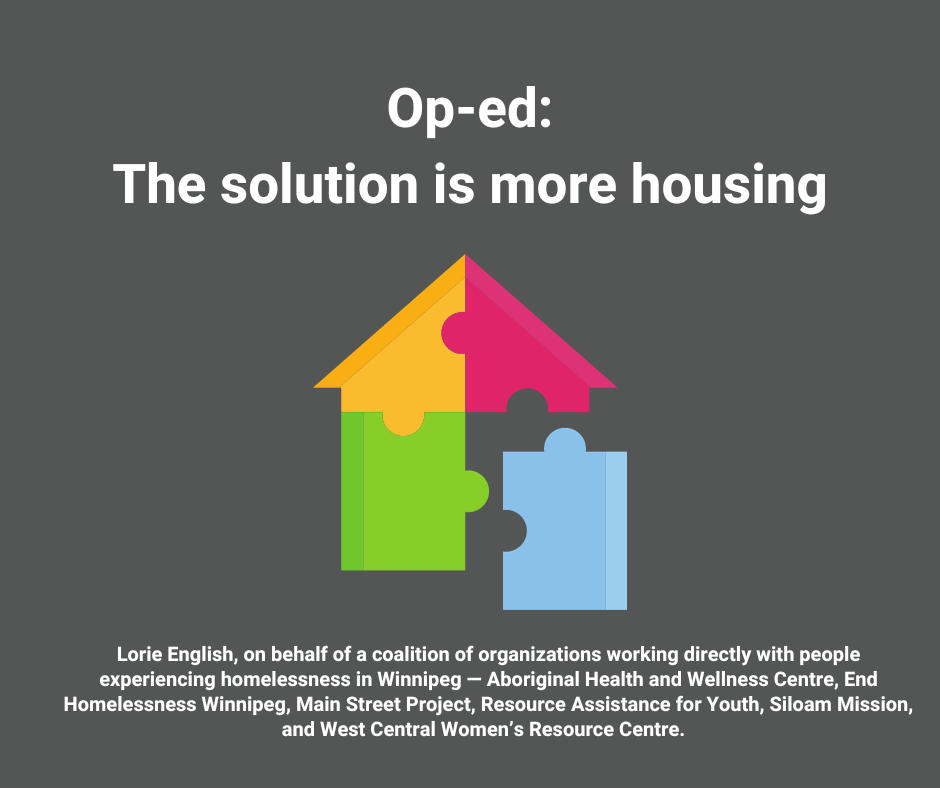Previously published in the Winnipeg Free Press October 11, 2023

There is a growing interest among politicians — including Winnipeg’s Mayor and those from Manitoba’s NDP — in learning from the “Houston model” to address homelessness. Those of us working to help transition people into housing cannot understand the fuss — this is the primary model we have used for almost 15 years. We know firsthand that Winnipeg does not need a “new” model — it needs more housing.
As noted in Jino Distasio’s Sept. 28 op-ed piece From Houston to Helsinki for housing, cities all over the world adopted Housing First long ago. To quote one of the architects of Finland’s Housing First approach, “It’s not rocket science…”. Move people experiencing homelessness into permanent housing as quickly as possible, and then offer support to stay housed and achieve their goals.
Winnipeg’s network of outreach teams work 24/7 to build relationships and connect people with Housing First programs that support people into permanent housing. The biggest challenge they face is finding housing that is affordable, safe, and appropriate when they need it.
Some find housing at Main Street Project’s Bell Hotel and Siloam Mission’s Madison Lodge, which offer a combined 125 permanent supportive housing units for people with a history that includes homelessness, mental illness, and addiction. Both have been operating successfully for more than ten years.
There is a desperate need for more permanent supportive housing options like these and other non-market housing models where rents are geared to income. A recent analysis revealed Manitoba requires 10,000 additional units to meet the need.
In writing about the Housing First model, Distasio notes that “the foundational principle is client choice in the … type and location of housing.” But Distasio fails to point out that this is not a reality here. Given limited housing options, the only choice people have is to take what is available at rents they can afford or remain unhoused. It is no surprise that many choose the latter.
With years-long social housing waitlists, people are forced into unsafe, poorly maintained low-rent private market housing that is only accessible through government subsidies. This public money goes into landlords’ pockets with no accountability for improvements. Instead of stabilizing and working on goals, people often enter into a cycle of homelessness and rehousing until an appropriate unit is available.
While both Winnipeg and Houston largely rely on the private sector to house people experiencing homelessness, Houston’s rental vacancy rate was 16.5 per cent when it adopted Housing First in 2011. Last year the rate was 8.9 per cent. Winnipeg’s rate is 2.7 per cent. Recent articles reveal the limitations of the private sector in Houston — rents are increasing, government rental subsidies are not keeping up, and investors who are buying up properties for profit no longer want to house the low-income tenants they inherited. This experience is all too common in cities across North America and Winnipeg is no exception.
If politicians can take any lesson from Houston, it is to stop relying on the private sector to house people experiencing homelessness. But there’s no need to look to Houston. Those working in Winnipeg’s homeless sector have spent decades pointing to non-market social housing as the only sustainable solution.
Instead of talking about housing, Distasio and others looking at Houston, like the mayor, have focused on the lack of coordination in Winnipeg around a comprehensive plan with a shared goal. This is also perplexing.
Winnipeg’s outreach teams already connect regularly to coordinate coverage across the city. In alignment with Kikininaw Oma, Winnipeg’s primary plan for supporting unsheltered people, they triage calls for support to ensure the most appropriate response is delivered. Another key recommendation in the plan is to implement a “coordinated access system” to streamline exits from homelessness. Winnipeg’s system, Naatamooskakowin, has been in place since March 2022. It enables outreach and Housing First teams to collaborate using a shared data system to prioritize and match people with housing.
Winnipeg is not lagging when it comes to coordination within the community. These suggestions only distract us from focusing on what’s really needed. If we are lagging anywhere, it’s on Kikininaw Oma’s remaining recommendations which include creating housing and enhancing income support. Rapid exits from homelessness are not possible if no housing is available, no matter how coordinated you are. This requires government leadership and investment.
The community is doing everything it can to implement Winnipeg’s plan with limited resources. We need all levels of government to collaborate with us by stepping up to coordinate their efforts to expand non-market social housing options that meet the needs of people experiencing homelessness in Winnipeg.
Lorie English, on behalf of a coalition of organizations working directly with people experiencing homelessness in Winnipeg — Aboriginal Health and Wellness Centre, End Homelessness Winnipeg, Main Street Project, Resource Assistance for Youth, Siloam Mission, and West Central Women’s Resource Centre and Lorie is a member of the Steering Committee of CCPA Manitoba.


